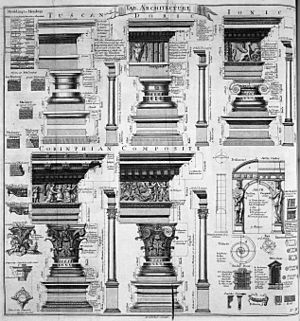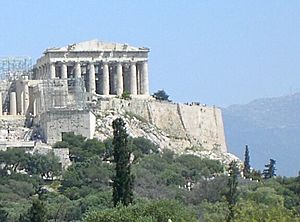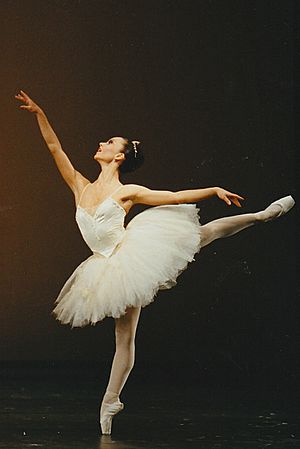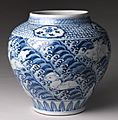Arts facts for kids
The arts are a big part of our culture. The word "arts" means much more than just "art". It includes many creative activities like visual arts (like painting and drawing), literary arts (like books and writing), and performing arts (like music, dance, and drama).
Sometimes, in universities, "the arts" is a shorter way to talk about a wider group of subjects called the humanities. These subjects also include philosophy, theology, literature, languages, and history.
"The arts" are usually seen as different from "The sciences".
Contents
Visual Arts
Visual arts are art forms that you can see. They include things like drawing, painting, sculpture, and photography.
Drawing
Drawing is a way to make an image. Artists use many different tools and methods. It usually means making marks on a surface by pressing a tool or moving it across the surface. Common tools are graphite pencils, pen and ink, inked brushes, wax colour pencils, crayons, charcoals, pastels, and markers. Digital tools that copy these effects are also used.
Some drawing methods include line drawing, hatching (making parallel lines), crosshatching (crossing lines), scribbling, stippling (making dots), and blending. An artist who is very good at drawing is called a drafter or draughtsman. Drawing is used in many creative fields like illustrations, comics, and animation.
Painting
Colour is super important in painting, just like sound is in music. Colours can make us feel different things, but how we feel about them can change from one culture to another. For example, black is often linked to sadness in Western countries, but white might be in other places.
Some painters and scientists, like Goethe and Newton, have written about their ideas on colour theory. The word for a colour, like "red," can mean many different shades of that colour. There isn't a strict list of colours like there are specific notes in music (like C or C#). However, the Pantone system is often used in printing to make sure colours are consistent.
Modern painters sometimes add other materials to their work, like in collage. A collage isn't painting in the usual way because it uses different materials. Some modern painters even use things like sand, cement, straw, wood, or hair to create interesting textures in their art. Examples include works by Elito Circa and Jean Dubuffet.
Ceramics
Ceramic art is made from ceramic materials, like clay. These can be shaped into many things, such as pottery, tiles, figurines, sculptures, and tableware. Some ceramic items are seen as fine art, while others are more for decoration or everyday use.
Ceramic art can be made by one person or a group. In a factory, many people might work together to design, make, and decorate pottery. When one artist makes pottery in their own studio, it's called studio pottery. In simple terms, ceramics is the art and science of making objects from non-metal materials using heat.
Photography
Art photography means taking pictures that show the photographer's creative ideas. This is different from photojournalism, which shows news events, or commercial photography, which is used to advertise products. Art photography is about expressing a vision.
Architecture
Architecture is the art and science of designing buildings and other structures. The word comes from Greek words meaning "master builder." It can also include designing whole environments, from towns and landscape architecture to even furniture. Architects need to think about if a building can be built, how much it will cost, how it will be used, and how it will look.

In a broader sense, architecture can mean the plan or design of any complex object or system. This could be the hidden design of music or mathematics, the natural design of rock formations, or the planned design of human-made things like software or computers. In all these cases, architecture helps us understand how different parts of a system fit together.
When designing buildings, architects use space, shape, texture, and light to create beautiful looks. This makes it different from engineering, which focuses more on how things work and if they are possible to build. Architects need many skills, whether they are designing a big hospital or a simple house. Many buildings are also important cultural or political symbols, or even works of art.
Sculpture
Sculpture is a type of visual arts that creates art in three dimensions (length, width, and height). It's one of the "plastic arts" because you can shape the materials. Traditionally, sculptures were made by carving (removing material) from stone or wood, or by modelling (adding material) with clay.
Today, sculptors have much more freedom with materials and methods. They can carve, assemble pieces by welding, model with clay, or use moulds and casting to create their art.
Conceptual Art
Conceptual art is a type of art where the main idea or concept behind the work is more important than how it looks or what it's made of. When the term started in the 1960s, it referred to art that focused strictly on ideas, often presented as text rather than traditional visual art.
Over time, the term became more widely used, especially in the UK, to mean any contemporary art that doesn't use the traditional skills of painting and sculpture.
Literary Arts
Literature generally means a collection of writings. In Western culture, this mainly includes prose (like fiction and non-fiction books), drama (plays), and poetry. In many parts of the world, artistic language can also be spoken, like oral stories, epics, legends, myths, and folktales.
Comics, which combine drawings or other visual arts with stories, are sometimes called the "ninth art" in French-speaking countries.
Performing Arts
Performing arts are art forms where a human performance is the main part. This includes dance, music, theatre, opera, and mime. They are different from visual arts (like painting) or literary arts (like books) because they need a live performance to be seen and experienced.
Each performing art happens over a period of time. Some performances can be repeated exactly (like from a script or musical score), while others are made up on the spot (improvised). Artists who perform in front of an audience are called performers. This includes actors, magicians, comedians, dancers, musicians, and singers. Other people, like songwriters and those who work on stagecraft, also help make these performances happen. Performers often change their look using costumes and stage makeup.
Music

Music is an art form that uses sound and silence over time. Key parts of music include pitch (how high or low a sound is, which creates melody and harmony), rhythm (the beat and timing), dynamics (how loud or soft), and the unique sound quality of different instruments or voices (timbre).
How music is made, performed, and understood changes depending on the culture and social setting. Music can range from carefully planned compositions to music that is made up on the spot. Music is divided into different types, or genres, but the lines between them can sometimes be blurry. Within "the arts," music is seen as a performing art and an auditory art (art you hear).
Theatre
Theatre (or theater) is a type of performing arts where stories are acted out in front of an audience. Performers use speech, gestures, music, dance, sounds, and visual effects. Besides plays with spoken dialogue, theatre also includes forms like opera, ballet, mime, kabuki (a Japanese theatre form), and Chinese opera.
Dance

Dance generally means human movement used to express feelings or performed in a social, spiritual, or performance setting. The word "dance" can also describe ways humans or animals communicate without words (like a bee dance), or even the motion of objects (like "the leaves danced in the wind").
Choreography is the art of creating dances, and the person who does this is called a choreographer. People often dance to relax or express themselves. What counts as dance depends on social, cultural, and artistic ideas. It can range from simple movements in Folk dance to complex, skilled techniques like ballet. In sports, gymnastics, figure skating, and synchronized swimming are like dance, and Martial arts "kata" are often compared to dances.
Some artistic works combine many different art forms. For example, film, opera, and performance art mix various disciplines. Opera is often grouped with music, but the word "opera" itself means "works" in Italian because it combines several arts into one experience. In a traditional opera, you'll find sets (visual arts), costumes (fashion), acting (dramatic performing arts), a story (literature), and singers with an orchestra (music).
The composer Richard Wagner saw how many arts came together in opera. He called his works Gesamtkunstwerk, which means "synthesis of the arts" or "total work of art" in German. This showed that the story and acting were just as important as the music. Classical ballet is another art form that started in the 17th century, combining orchestral music with dance.
In recent times, other works have blended different arts in new ways, such as performance art. Performance art is a show that happens over time, combining many instruments, objects, and art forms within a planned or less structured way. Some parts might even be made up on the spot, and the audience might sometimes join in.
Images for kids
-
Lawrence Alma-Tadema's Catullus-at-Lesbia's (1865)
-
Chinese blue and white porcelain jar, Ming dynasty, 15th century
-
Adumu, a traditional Maasai jumping dance
-
Ernestine Schumann-Heink as Waltraute
See also
 In Spanish: Numeración de las artes para niños
In Spanish: Numeración de las artes para niños









